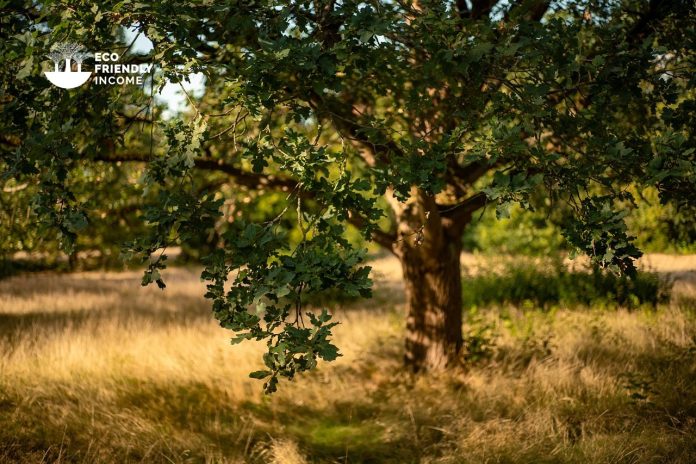A field guide on how to identify and propagate Common Oak (Quercus robur), a hardy tree that is native to most of Europe west of the Caucasus.
How to Identify Common Oak (Quercus robur)
Leaves
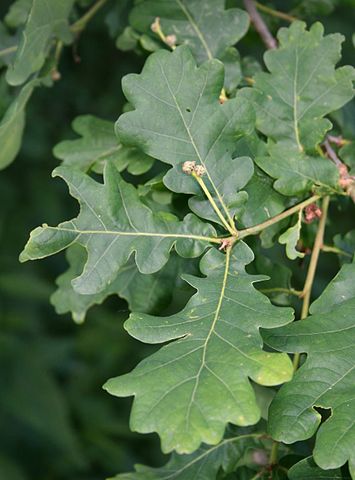
Common Oak leaves are obovate-shaped with lobate margins and grow in an alternate arrangement on the stems.
Bark
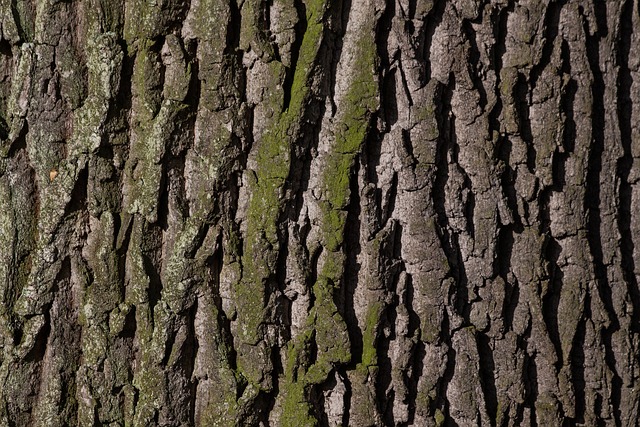
The bark is typically dark brown and furrowed, with deep ridges and shallow grooves. It is often rough and scaly, with small, hard, pointed ridges that are about an inch long.
Common oak bark may also have small patches of gray, green, or black lichen growing on it.
Fruit
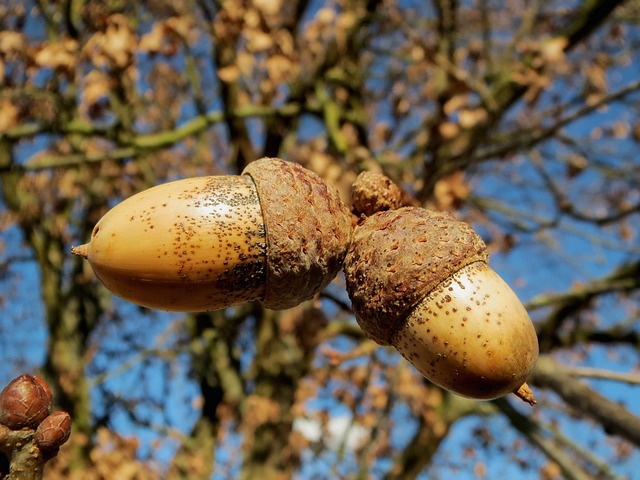
Common oak is a deciduous tree that produces acorns as its fruit.
The acorns are usually 1 to 2 cm long and have a hard, round, smooth shell.
The fruit is a nut, containing a single seed encased in a hard, woody shell.
Inside the shell is a light-brown nut, which is edible and rich in protein, fat, carbohydrates, and minerals.
Flowering Season
Acorns typically appear on common oak trees between late summer and early fall.
They will be ripe and start falling on the ground usually from September to October.
The tree needs to be about 20 years old before it can produce acorns.
Habitat
Quercus robur, commonly known as the English oak, is found in a variety of habitats across Europe and parts of Asia.
It is most commonly found in moist, well-drained soils in areas with a mild climate and abundant rainfall, such as woodlands, hedgerows, riverbanks, valleys, and coastal areas.
It is also sometimes found in drier, more exposed habitats, such as heathland, sand dunes, and chalk downland.
Some other understory plants that associate with common oak are:
- Field Maple (Acer campestre)
- Rockspray cotoneaster (Cotoneaster horizontalis)
- Common hawthorn (Crataegus monogyna)
- Common Ash (Fraxinus excelsior)
- Wild cherry (Prunus avium)
- Rowan (Sorbus aucuparia)
- Field elm (Ulmus minor)
Wildlife Value
Common oak provides an important habitat for a variety of wildlife, including birds, mammals, and insects.
This species of oak tree is an important source of food and shelter for many species, particularly birds.
It also provides nesting sites for many species, including owls, woodpeckers, and other cavity-nesting birds.
Their acorns are eaten by animals such as squirrels, jays, woodpeckers, ducks, bears, and deer.
In addition, the tree’s fallen leaves provide shelter and food for small mammals, such as voles, mice, and shrews, as well as providing a home for insects, such as butterflies and moths.
How to Propagate Common Oak (Quercus robur)

Hardiness Zone: 4-8

Soil Type: Well-drained clay, loam, chalk, sand.

Water: Normal.

Exposure: Full Sun
You can propagate common oak (Quercus robur) with two effective methods:
- Stem Cuttings: It provides established trees faster, but is tricky, and could have a lower success rate.
- By Seed: The success rate is high but takes longer to get established saplings.
The thing with oak trees is that they don’t produce acorns frequently, in some regions it may take multiple years between each harvest.
In this regard, it’s nice to have another propagation technique for the years without acorn harvests.
And as a matter of fact, oaks propagate quite well by cuttings.
Let’s take a look at both methods:
How to Propagate Common Oak (Quercus robur) by Seed
If you want to propagate oak by seed, you’ll have to find a mature oak tree that’s producing acorns this year.
They don’t produce them every year, so at this point, I suppose it will be a matter of luck.
If you don’t have access to a tree, you could order the seeds online at pikes peak nursery.
How to Harvest Seeds
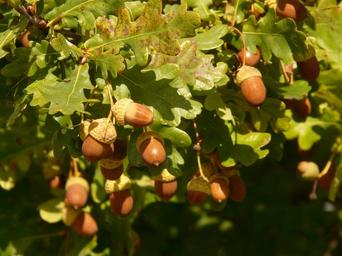
First, to harvest common oak seeds, you need to wait until autumn for the acorns to ripen.
It’s preferable to pick directly from the tree, to avoid chances of fallen acorns that have dried out or been damaged by insects.
Tip: A good way to tell if your acorn is mature is that you’ll be able to separate the cap from the acorn easily without tearing the seed coat.
Sowing
Common oak does not require a cold stratification period before sowing, they can be sown just after harvesting.
They can be stored to be sown at a later date, but under moist conditions to avoid drying. If you want to plant them at a later time, store them in ziplock bags along with moist sand, and place them into your refrigerator (Not the freezer, as this will kill them).
How to sow:
- First, fill a pot with potting soil.
- Next, place the acorns on top of the soil, spacing them out evenly.
- Then, cover the acorns with a thin layer of soil.
- Next, water the pot until the soil is damp but not saturated.
- Then, place the pot in a warm, sunny spot indoors or outdoors.
- Keep the soil moist but not soggy.
- Once the acorns have sprouted, thin out the seedlings to give the strongest one room to grow.
- Finally, when the seedlings are about 6 inches tall, transplant them outdoors in a sunny spot.
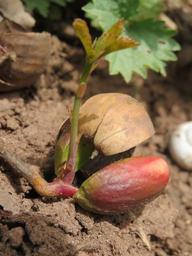
Oak acorns take between 4-6 weeks before they germinate.
How to Propagate Common Oak (Quercus robur) by Cuttings
Your other choice to propagate common oak is to take stem cuttings.
Important: Take cuttings only from young trees, older trees lose their ability to regenerate over the years.
The timing will depend on where you live, but generally, a good time to harvest cuttings is from the end of May until the end of August.

Now here’s how to get your oak cuttings:
- First, identify branches that are new growth from the previous year, they should be still on the green side. Note: You can take a whole branch and make multiple cuttings from it.
- Snip the branch just below a node, and make sure the width of the cutting is not too thin, 1/4″ to 1/2″ width each is needed.
- Snip off any branches forking from the main stem, then cut your branch into cuttings 6-8 inches long each. Always snip below the nodes.
Step 2: Root the Cuttings
- First, scuff up the base of the cutting to expose the cambium.
- Next, dip the end of your cuttings in rooting hormone.
- Then, use a stick to make a hole in your rooting medium.
- Next, place your cutting into the hole and compact the soil around it.
- Finally, cover the propagation box, and water regularly.
Oak cutting should form roots in about 6 weeks.
Recommended rooting medium: 3:1 Perlite & Peat, with slow-releasing fertilizer, ex. Osmocote Exact.
FAQ
Q: What season do acorns grow on oak trees?
A: Acorns grow during late summer, then are ripe and fall on the ground by mid-autumn.
Q: How old does your oak tree need to be to produce acorns?
A: Healthy oak trees typically produce their first acorns at 20 years old, but only reach peak acorn production at 50-80 years.
Q: Do common oak make acorns every year?
A: It varies from region to region, but generally, oaks only produce acorns every 2-3 years.
Q: What is the difference between Quercus robur and Quercus Petraea?
A: In Q. robur, the main trunk tends to be lost in the crown, resulting in irregular boughs with twisting branches. Q. petraea, however, usually has a main trunk gradually decreasing in size. Both species have grey, fissured bark that forms rectangular elongate blocks. The bark on Q. robur is thicker than that of Q. petraea.

